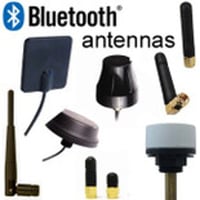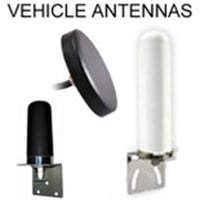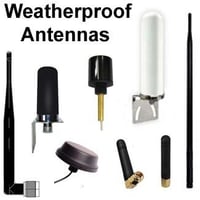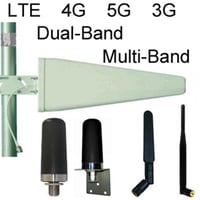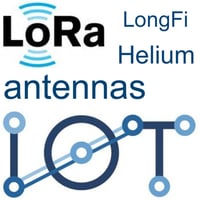850-950MHz Antennas with RP-SMA connector
RP-SMA Antennas for the 850-950 Mhz Frequency Band
All of our antennas in this subcategory are compatible with Helium Network devices (US), and LoRaWAN devices.
Use of 900 MHz Frequency Band to Pass Signal through Trees
Frequencies 900MHz and 2.4GHz are Best for Penetration of Obstacles such as Trees.
The rule of thumb is that the lower the frequency the better the range. All things held constant (antenna gain, RF power, etc) you should be using lower frequencies to get better range. Thus lower frequencies such as 900MHz have better range (but lower signal strength) and will penetrate through obstacles better than higher frequencies such as the 2.4GHz or the 5.8GHz.
To pass through tree(s): You can use 2.4GHz or 900MHz: Depending on thickness of trees: If the tree(s) are not too thick or if your link is from a high point to a low point, 2.4GHz will probably suffice. But if 2.4GHz is over-crowded or the tree(s) are thick, 900MHz would be a better solution. The lowest-cost option for a short link, to pass through a single thick tree, or a small group of trees, is to use a LOCOM9 on each end of the link.
900MHz and its Effectiveness with No Line of Sight Applications
It can be difficult to establish point to multipoint or point to point wireless links when you have buildings, trees and other obstructions in the line of sight.
Of all the unlicensed ISM frequencies in the world, the low-frequency 900MHz is perfect when you have a no line of sight situation due to having to pass the signal through trees and forests. It will not be absorbed by leaves or water unlike signals from the higher frequency 2.4GHz. This means that the 900MHz is perfect when dealing with foliage and trees in the line of sight. Since it has a very low frequency it penetrates obstructions such as buildings and trees for up to 1500 feet.
Moreover, 900MHz frequencies can not only pass through obstacles such as trees and buildings, but they can also diffract around them if they are too thick, as long as there is enough room.
Drawbacks of the 900MHz Frequency Band
While the 850-950MHz frequency band is the best for passing signal through trees and obstructions, it has a few drawbacks that include:
- Limited Bandwidth in the Spectrum – There are only 26MHz in the 900 MHz spectrum as compared to almost 400 in the 5.8GHz band. This means that there may be a lot more devices using the same spectrum such as baby monitors, paging towers and such, which may interfere with the quality of your signal.
- You get significantly lower data rates on the 900MHz bad as compared to the 2.4GHz or the 5.8MHz band. Most of the time you will only get between 1 and 1.5 Mbps and no more. This is very little, say when compared to the 10 to 20 mb/s on the 5.8GHz frequency.
- The 900MHz frequency cannot be used without a license in most countries of the world except for the United States, New Zealand, Australia, Brazil, and Canada.
850 to 950 MHz RP-SMA antennas
850 to 950 MHz antennas are resonant at frequencies between 850 and 850 MHz. These sub-gigahertz frequencies span several key frequencies including the 900 MHz frequency band or the 33-centimeter band (902-928 MHz). 900 MHz is designated an Industrial, Scientific, and Medical (ISM) band in the Americas (region 2). This means it is unlicensed and can be legally used for a range of amateur, cellular and networking applications as outlined further on.
900 MHz antennas come in a range of designs and specifications. The RP-SMA antenna is a common termination for antennas used in wireless networking and ensures a secure mechanical and electrical connection for the antenna keeping reflections and signal attenuation to a strict minimum. RP-SMA connectors are typically soldered onto the antenna cable within the antenna's radome, with the central conductor of the antenna being capped with the antenna's center pin. Correct soldering creates a durable connection with good electrical continuity between the antenna and the connector.
Antennas with an RP-SMA connector
RP-SMA antennas include those that have a cable to an RP-SMA-male connector. RP-SMA stands for Reverse Polarity Sub Miniature Version A and is a variant of the standard SMA connector originally designed according to military specifications (MIL-C-39012) in the late 1950s by James Cheal. The RP-SMA version was created in the late 1990s alongside the expansion of consumer wireless networking equipment. It is now in widespread use. Though it appears externally identical to the standard SMA connector, the gender of the inner mating interface of RP-SMA connectors is reversed, making SMA and RP-SMA connectors deliberately incompatible. The two connector types are capable of making a physical connection but are unable to connect electrically. This was done at the direction of the Federal Communications Commission (FCC) to prevent professional-grade antennas being connected to consumer wireless devices.
Key physical characteristics of the RP-SMA connector
This subminiature (0.25 inch, 6.35-millimeter diameter), semi-precision, threaded connector is mated by screw-on coupling which can be tightened with an SMA wrench via the 5/16 inch hex nut on the male connector. It is usually made from brass or stainless steel with gold or copper plated inner conductors. The male RP SMA connector has internalized threads with a center receptacle surrounded by a PTFE dielectric. The female RP-SMA connector has a threaded barrel with externalized threads and carries a center pin. RP-SMA connectors are typically rated for 500 mating cycles, making them a durable, high-performing connector for external antennas.
Electrical specifications of the RP-SMA connector
The electrical profile of the RP-SMA connector is precisely aligned with the antenna’s conductive elements, particularly impedance which is standardized at 50 Ohms to balance power handling and attenuation in the radio frequency circuit the antenna is attached to.
- Maximum operating frequency: 18 GHz
- Impedance: 50 Ohms
- Voltage rating: 375 to 500 volts
- VSWR: 1.15
- Radio frequency leakage at 2-3 GHz: -90 db min.
Key types of 900 MHz RP-SMA antennas
[A] 850 to 900 MHz whip antenna: Whip antennas consist of a flexible wire or rod with an RP-SMA connector at its base. It is a great choice for installing on vehicles or in areas where the antenna could suffer impacts as the flexible wire is unlikely to break. The length of a whip antenna is always proportional to the wavelength (33 centimeters or 12.9 in MHz) of the antenna’s frequency, usually a quarter-wave or half-wavelength antenna. These monopole antennas have an omnidirectional antenna pattern and may require a ground plane, a small metal circular disc at the antenna base to reflect radio waves, for optimal performance.
[B] 850 to 900 MHz dipole antenna: Dipole antennas are made from two conductive elements with a feedline in between them. They are simple and the RP-SMA makes them easy to attach to antenna cable or directly to a radio device. They can be half or quarter-wave antennas and are omnidirectional.
Many dipole antennas (especially used on routers or cellular equipment) are articulating and able to be bent at an angle up to 90 degrees. In these antennas, the antenna cable runs through the moving joint of the antenna to the RP-SMA connector. This makes the antenna vulnerable to moisture ingress so this type of dipole antenna is not suitable for outdoor installation.
[C] 850 to 900 MHz puck antenna: Puck antennas are named because of their physical resemblance to an ice hockey puck. They are low-profile, ground independent omnidirectional antennas and provide good coverage when wall or ceiling mounted. Their through-hole mount design is also suitable for marine or vehicle roofs and can be reinforced against the weather by using seals and gaskets.
[D] 850 to 900 MHz rubber duck antenna: Rubber ducky antennas are short monopole antennas that consist of a rubber-coated coiled and springy antenna wire. The length of the antenna wire is usually shorter than a quarter of the wavelength of the antenna frequency. This variant of the helical antenna is often mounted directly onto devices and its flexibility makes it resistant to impact and preferable to telescopic or stiff wire antennas. Rubber duck antennas are omnidirectional, but the spacing of the coils and the diameter of the helix determine the antenna bandwidth.
[E] Omnidirectional antenna with integrated cable assembly: These antennas are connected to a length of coaxial cable which is terminated by the RP-SMA connector at the end of its length. It is an advantageous design for setups where the antenna is mounted at a distance from the radio device it is attached to.
Why are 850 to 950 MHz RP-SMA antennas important?
This diverse range of antennas is capable of supporting 900 MHz communications and connectivity in both indoor and outdoor settings. The 900 MHz frequency band supports several types of wireless connectivity and numerous applications which is currently being vastly expanded by many IoT and M2M networking protocols, some of which are explored below. External 900 MHz antennas are therefore capable of adding gain, coverage, and efficient performance to the radio systems they are part of and the RP-SMA connector is in widespread use on devices for easy connection. When selecting a 900 MHz antenna, its characteristics should be carefully evaluated to ensure that it is a suitable match for its intended application. Some key properties to always review when selecting an antenna are:
- Bandwidth: this is the frequency range over which the antenna performs according to its specified parameters.
- Antenna pattern: the radiation pattern of an antenna is a graphical representation of an antenna's radiated power in a specific plane.
- Directivity: the concentration of the antennas emission or capture of electromagnetic energy in a particular direction, differentiating directional antennas from omnidirectional antennas.
- Gain: antenna gain combines antenna directivity and electrical efficiency to provide a measure of the radiated power of the antenna.
- Polarization: the orientation in which radio waves are emitted from or received by an antenna. This may be horizontal, vertical, circular, or elliptical
Using a sub-gigahertz frequency band
As a sub 1 GHz frequency, the 900 MHz frequency band provides many advantages for reliable networking when compared to its higher frequency ISM band counterparts.
- Range
The distances that can be achieved by transmissions at 900 MHz compared to 2.4 and 5GHz are much greater given equivalent transmission power. 900 MHz transmission distances will easily exceed a kilometer, versus the tens of meters achieved at 2.4 GHz. This makes 900 MHz advantageous for long-range networking solutions and wireless links which can operate with fewer hops between nodes.
- Signal propagation
900 MHz signal propagation is predominantly by line of sight. Therefore antennas need to be mounted at a height to avoid obstructions like hills or large buildings. The 900 MHz signal is more resistant to path loss and fading than the higher ISM frequencies.
- Signal penetration
900 MHz has far greater penetration of buildings and vegetation than the frequency bands above 1 GHz.
- Power consumption
Because 900 MHz transmission covers greater distances with less attenuation, less energy is required. Networking at this frequency is often narrow-band which is more power-efficient due to increased receiver sensitivity. Smaller data packets and intermittent or asynchronous transmission extend the battery life of battery-powered devices that are deployed long-term.
- Data rates
The use of the 900 MHz frequency band is associated with lower throughput connectivity than at 2.4 GHz or 5GHz. Speeds are lower with data rates of up to 2 Mbps compared with 54 Mbps with 802.11g at 2.4 GHz.
- Antenna size
As radio frequency reduces, antenna size increases in line with wavelength. 850-950 MHz antennas are therefore larger than 2.4 GHz and 5 GHz antennas
- Interference
The 2.4 GHz frequency band in particular has a lot of congestion due to WiFi and other license-free wireless networking. However, cordless phones that operate at 900 MHz will cause interference if used in proximity to other 900 MHz devices.
900 MHz is a quieter portion of the spectrum and is also more resilient against multipath interference. There is also an inverse relationship between receiver sensitivity and channel bandwidth, which means that narrowband connectivity used by certain forms of LP-WAN networking at 900 MHz is efficient and less prone to interference.
900 MHz RP-SMA antennas for Low Power Wide Area Networks (LP-WANs)
900 MHz connectivity can be used to support the LP-WAN protocols that are used for large scale or industrial Internet of Things (IoT) or M2M networks. IoT networks need to be capable of providing connectivity to a potentially unlimited number of networked objects which each send small amounts of data at varying intervals. LP-WANs are seen as the solution for not only supporting but growing this type of technology in a range of industrial, commercial, and infrastructural sectors. The currently available networking protocols are seen as candidates for the IoT standard that will become globally adopted alongside the roll-out of 5G.
850-950 MHz external antennas can be used for wireless access points, repeaters and be directly attached to networked devices. Several open-source, proprietary, and licensed wireless networking standards deliver scalable solutions that take advantage of the long-range, low energy connectivity that can be achieved at this frequency. Key LP-WAN networking standards include:
- NB-IoT: Narrow Band Internet of Things is a proprietary networking standard devised by the Third Generation Partnership Project (3GPP). It uses cellular infrastructure and networking to deliver LP-WAN connectivity to cellular devices. As a licensed service NB-IoT is offered at a premium but is capable of supporting a high number and density of devices. By using a single 200 kHz narrowband, low data rate, long-distance transmissions can be made by enabled objects with no limit on the duty cycle. NB-IoT can run concurrently with GSM / LTE at 900 MHz and offers a level of security for LP-WANS comparable with cellular networking. Chipsets and network operator costs are currently comparable to those of cellular networking but are expected to fall.
- LoRa WAN: LoRa stands for Long Range and is an LP-WAN protocol owned by Semtech. It uses a modified chirp spread spectrum modulation technique to transmit power efficiently. LoRa provides the low power, long-distance connectivity that is suitable for IoT applications Its patented chipsets are integrated into a wide range of devices for scalable star and mesh networks. Networked devices transmit data whenever they have it available to send. Data packets are forwarded from node to node to a central controller, with a peak data rate of 27 kbps.
- SigFox: SigFox is an alternative LP-WAN technology that provides turnkey wireless networks for IoT / M2M infrastructure projects like utility metering. SigFox networks utilize hopping with star or mesh topology and a central controller. This ultra-narrowband network supports connected objects making up to 140 uplink transmissions daily data rates of up to 100 Mbps. Keeping data rates down and limiting the number of transmissions extends battery life and narrowband networking has greater spectral efficiency and receiver sensitivity.
900 MHz RP-SMA antennas for HaLow WiFi
The 900 MHz band can support longer-range WiFi connectivity as specified in the 802.11ah HaLow protocol. HaLow has been created by the Institute of Electronics and Electrical Engineers to provide a WiFi-based alternative to LP-WAN networking that is capable of supporting large scale IoT networks. It takes advantage of the better penetration and propagation characteristics of the 900 MHz frequency to produce longer distance and lower energy networks with data speeds of up to 347 Mbps. This variant of WiFi is not backward compatible with other versions of WiFi and will require specific equipment for deployment.
900 MHz RP-SMA antennas for GSM cellular networking
In the US, Global System for Mobile (GSM) digital cellular networks operates at 900 MHz. GSM is a global cellular networking technology that supports voice telephony, SMS, and data packet transfer for internet connectivity through its EDGE and GPRS extensions. It is essentially second-generation (2G) cellular technology and requires the use of a Subscriber Identification Module (SIM) card for connected devices to operate. NB-IoT operates concurrently with GSM on a similar basis.850-950 MHz antennas can be used to improve indoor cellular connectivity as part of a cellular repeater or booster arrangement. An external 900 MHz antenna can be erected at height outside of the building to pick up a weak cellular signal and relay it to a cellular booster which is capable of amplifying the signal. The improved signal can then be relayed via antenna cable to a suitably positioned omnidirectional 900 MHz antenna inside the building.
850-950 MHz antennas for 900 MHz wireless links
With the density of traffic at higher frequencies like 2.4 and 5 GHz, the 900 MHz frequency band is being revisited as a robust frequency for data applications. The propagation properties of this frequency make it ideal for outdoor wireless links. Aironet and Ubiquiti are well known for producing wireless access points, base stations, and routers that operate at 900 MHz, and legacy equipment can be used with external 900 MHz antennas for long-range connectivity and creating an internet backbone. For best results, 900 MHz antennas should be mounted at height and very accurately aimed.
850-950 MHz antennas for amateur radio
33-centimeter band amateur radio is legal, but the frequency band is shared with other users and interference has to be tolerated. 900 MHz radio equipment is not widely available and amateurs often use cellular equipment (mainly Motorola) or self-built transverters and repeaters. Amateur radio uses include amateur television, CW, FM, and single sideband.
Can a 900 MHz antenna with RP-SMA connector be connected to a different class of radio frequency connector?
If you want to connect an RP-SMA antenna to a different type of connector you will need to utilize an appropriate adapter to make an electrically sound connection. RP-SMA and SMA connectors are often confused but can be connected using an RP-SMA to SMA adapter of the appropriate genders. This may be a single adapter coupler or a length of coaxial cable capped with the appropriate connectors. For PCB mounted antenna connectors u.FL and MMCX pigtail adapters permit the connection of an external 900 MHz antenna to the PCB via the pigtail with an RP-SMA connector attached.
In conclusion
External 850-950 MHz antennas are essential to provide wireless and cellular networking for a diverse range of applications. The RP-SMA connector is a practical pairing for these antennas due to its widespread use and reliable electrical and mechanical performance.
LEARN MORE:


